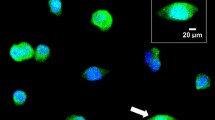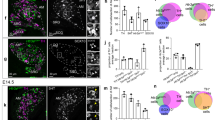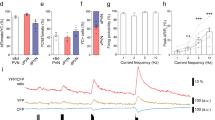Abstract
Corticotropin-releasing hormone (CRH) is the principal regulator of the hypothalamic-pituitary-adrenal (HPA) axis and an activator of the sympathoadrenal (SA) and systemic sympathetic (SS) systems. Mental disorders, including major depression and, more recently, Alzheimer's disease have been associated with dysregulation of the HPA axis and the SA/SS systems. Treatment of rats or monkeys with the novel CRH receptor type 1 (CRH-R1) antagonist antalarmin inhibits the HPA and/or the SA/SS axes. This is the first study to examine the potential direct effect of antalarmin on human adrenal function. Adrenocortical and adrenomedullary cells were characterized by double-immunohistochemistry with anti-17 α hydroxylase (cortical cells) and anti-chromogranin A (chromaffin cells). Expression of CRH, ACTH, CRH type I and type II receptor mRNA were analyzed by reverse-transcription (RT) PCR. Human adrenal cortical and/or chromaffin cells in co-culture were incubated with CRH, antalarmin, and both CRH and antalarmin in vitro. Exposure of these cells to corticotropin or vehicle medium served as positive and negative controls, respectively. Cortical and chromaffin tissues were interwoven in the human adrenals, and both in situ and in the co-culture system the endocrine cell types were in close cellular contact. ACTH, CRH, and CRH-R1 and CRH-R2 mRNAs were expressed in the human adrenal as determined by RT-PCR. CRH (10−8 M) led to a moderate increase of cortisol release (145.7 ± 20.0%) from cortical and chromaffin adrenal cells in co-culture. This effect corresponded to 41.8% of the maximal increase induced by ACTH (10−8 M). The action of CRH was completely inhibited by antalarmin. CRH, ACTH, and both CRH-R1 and CRH-R2 mRNAs are expressed in the adult human adrenal gland. CRH stimulates cortisol production in cortical and chromaffin cell co-cultures. This effect is blocked by antalarmin, a selective CRH-R1 receptor antagonist, suggesting that CRH-R1 receptors are involved in an intraadrenal CRH/ACTH control system in humans.
This is a preview of subscription content, access via your institution
Access options
Subscribe to this journal
Receive 12 print issues and online access
$259.00 per year
only $21.58 per issue
Buy this article
- Purchase on Springer Link
- Instant access to full article PDF
Prices may be subject to local taxes which are calculated during checkout



Similar content being viewed by others
References
Wong ML, Licinio J, Pasternak KI, Gold PW . Localization of corticotropin-releasing hormone (CRH) receptor mRNA in adult rat brain by in situ hybridization histochemistry Endocrinology 1994; 135: 2275–2278
Vale W, Spiess J, Rivier C, Rivier J . Characterization of a 41-residue ovine hypothalamic peptide that stimulates secretion of corticotropin and beta-endorphin Science 1981; 213: 1394–1397
Vita N, Laurent P, Lefort S, Chalon P, Lelias JM, Kaghad M et al. Primary structure and functional expression of mouse pituitary and human brain corticotrophin releasing factor receptors FEBS Lett 1993; 335: 1–5
Liaw CW, Lovenberg TW, Barry G, Oltersdorf T, Grigoriadis DE, de Souza EB . Cloning and characterization of the human corticotropin-releasing factor-2 receptor complementary deoxyribonucleic acid Endocrinology 1996; 137: 72–77
Andreis PG, Neri G, Belloni AS, Mazzocchi G, Kasprzak A, Nussdorfer GG . Interleukin-1 beta enhances corticosterone secretion by acting directly on the rat adrenal gland Endocrinology 1991; 129: 53–57
Smith R, Mesiano S, Chan EC, Brown S, Jaffe RB . Corticotropin-releasing hormone directly and preferentially stimulates dehydroepiandrosterone sulfate secretion by human fetal adrenal cells J Clin Endocrinol Metab 1998; 83: 2916–2920
Chakravorty A, Mesiano S, Jaffe RB . Corticotropin-releasing hormone stimulates P450 17alpha-hydroxylase/17,20-lyase in human fetal adrenal cells via protein kinase C J. Clin Endocrinol Metab 1999; 84: 3732–3738
Raadsheer FC, van Heerikhuize JJ, Lucassen PJ, Hoogendijk WJ, Tilders FJ, Swaab DF . Corticotropin-releasing hormone mRNA levels in the paraventricular nucleus of patients with Alzheimer's disease and depression Am J Psychiatry 1995; 152: 1372–1376
Luger A, Deuster PA, Kyle SB, Gallucci WT, Montgomery LC, Gold PW et al. Acute hypothalamic-pituitary-adrenal responses to the stress of treadmill exercise. Physiologic adaptions to physical training N Engl J Med 1987; 316: 1309–1315
Gold PW, Pigott TA, Kling MA, Kalogeras K, Chrousos GP . Basic and clinical studies with corticotropin-releasing hormone. Implications for a possible role in panic disorder Psychiatr Clin North Am 1988; 11: 327–334
Bornstein SR, Webster EL, Tropy DJ, Richman SJ, Mitsiades N, Igel M et al. Chronic effects of a nonpeptide corticotropin-releasing hormone type 1 receptor antagonist on pituitary-adrenal function, body weight, and metabolic regulation Endocrinology 1998; 139: 1546–1555
Wong ML, Webster EL, Spokes H, Phu P, Ehrhart-Bornstein M, Bornstein SR et al. Chronic administration of the non-peptide CRH type 1 receptor antagonist antalarmin does not blunt hypothalamic-pituitary-adrenal axis responses to acute immobilization stress Life Sci 1999; 65: PL53–58
Deak T, Nguyen KT, Ehrlich AL, Watkins LR, Spencer RL, Maier SF et al. The impact of the nonpeptide corticotropin-releasing hormone antagonist antalarmin on behavioral and endocrine responses to stress Endocrinology 1999; 140: 79–86
Willenberg HS, Stratakis CA, Marx C, Ehrhart-Bornstein M, Chrousos GP, Bornstein SR . Aberrant interleukin-1 receptors in a cortisol-secreting adrenal adenoma causing Cushing's syndrome N Engl J Med 1998; 339: 27–31
Haidan A, Bornstein SR, Glasow A, Uhlmann K, Lubke C, Ehrhart-Bornstein M . Basal steroidogenic activity of adrenocortical cells is increased 10-fold by coculture with chromaffin cells Endocrinology 1998; 139: 772–780
Webster EL, Lewis DB, Torpy DJ, Zachman EK, Rice KC, Chrousos GP . In vivo and in vitro characterization of antalarmin, a nonpeptide corticotropin-releasing hormone (CRH) receptor antagonist: suppression of pituitary ACTH release and peripheral inflammation Endocrinology 1996; 137: 5747–5750
Nussdorfer, Mazzocchi G . Immune-endocrine interactions in the mammalian adrenal gland: facts and hypotheses Int Rev Cytol 1998; 183: 143–184
Suda T, Tomori N, Tozawa F, Mouri T, Demura H, Shizume K . Distribution and characterization of immunoreactive corticotropin-releasing factor in human tissues J Clin Endocrinol Metab 1984; 59: 861–866
Suda T, Tomori N, Tozawa F, Demura H, Shizume K, Mouri T et al. Immunoreactive corticotropin and corticotropin-releasing factor in human hypothalamus, adrenal, lung cancer, and pheochromocytoma J Clin Endocrinol Metab 1984; 58: 919–924
Bruhn TO, Engeland WC, Anthony ELP, Gann DS, Jackson IMD . Corticotropin-releasing factor in the dog adrenal medulla is secreted in response to hemorrhage Endocrinology 1987; 120: 25–33
Edwards AV, Jones CT . Secretion of corticotropin releasing factor from the adrenal during splanchnic nerve stimulation in conscious calves J Physiol 1988; 400: 89–100
McDonald TJ, Nathanielsz PW . The involvement of innervation in the regulation of fetal adrenal steroidogenesis Horm Metab Res 1998; 30: 297–302
Venihaki M, Gravanis A, Margioris AN . Comparative study between normal rat chromaffin and PC12 rat pheochromocytoma cells: production and effects of corticotropin-releasing hormone Endocrinology 1997; 138: 698–704
Ehrhart-Bornstein M, Hinson JP, Bornstein SR, Scherbaum WA, Vinson GP . Intraadrenal interactions in the regulation of adrenocortical steroidogenesis Endocr Rev 1998; 19: 101–143
Pignatelli D, Magalhães MM, Magalhães MC . Direct effects of stress on adrenocortical function Horm Metab Res 1998; 30: 464–474
Bagdy G, Calogero AE, Szemeredi K, Chrousos GP, Gold PW . Effects of cortisol treatment on brain and adrenal corticotropin-releasing hormone (CRH) content and other parameters regulated by CRH Regul Pept 1990; 31: 83–92
Mazzocchi G, Malendowicz LK, Markowska A, Nussdorfer GG . Effect of hypophysectomy on corticotropin-releasing hormone and adrenocorticotropin immunoreactivities in the rat adrenal gland Mol Cell Neurosci 1994; 5: 345–349
Bornstein SR, Vaudry H . Paracrine and neuroendocrine regulation of the adrenal gland—basic and clinical aspects Horm Metab Res 1998; 30: 292–296
Grigoriadis DE, Lovenberg TW, Chalmers D, Liaw C, DeSouza EB . Characterization of corticotropin-releasing factor receptor subtypes Ann NY Acad Sci 1996; 780: 60–80
Stenzel P, Kesterson R, Yeung W, Cone RD, Rittenberg MB, Stenzel-Poore MP . Identification of a novel murine receptor for corticotropin-releasing hormone expressed in the heart Mol Endocrinol 1995; 9: 637–645
Kishimoto T, Pearse RV, Lin CR, Rosenfeld MG . A sauvagine/corticotropin-releasing factor receptor expressed in heart and skeletal muscle Proc Natl Acad Sci USA 1995; 92: 1108–1112
Chen R, Lewis KA, Perrin MH, Vale WW . Expression cloning of a human corticotropin-releasing factor receptor Proc Natl Acad Sci USA 1993; 90: 8967–8971
Lovenberg TW, Liaw CW, Grigoriadis DE, Clevenger W, Chalmers DT, DeSouza EB et al. Cloning and characterization of a functionally distinct corticotropin-releasing factor receptor subtype from rat brain Proc Natl Acad Sci USA 1995; 92: 836–840
Chang CP, Pearse RV, O'Connell S, Rosenfeld MG . Identification of a seven transmembrane helix receptor for corticotropin-releasing factor and sauvagine in mammalian brain Neuron 1993; 133: 3058–3061
Perrin MH, Donaldson CJ, Chen R, Lewis KA, Vale WW . Cloning and functional expression of a rat brain corticotropin releasing factor (CRF) receptor Endocrinology 1993; 133: 3058–3061
Bornstein SR, Gonzalez-Hernandez JA, Ehrhart-Bornstein M, Adler G, Scherbaum WA . Intimate contact of chromaffin and cortical cells within the human adrenal gland forms the cellular basis for important intraadrenal interactions J Clin Endocrinol Metab 1994; 78: 225–232
Marx C, Ehrhart-Bornstein M, Scherbaum WA, Bornstein SR . Regulation of adrenocortical function by cytokines—relevance for immune-endocrine interaction Horm Metab Res 1998; 30: 416–420
Path G, Bornstein SR, Ehrhart-Bornstein M, Scherbaum WA . Interleukin-6 and the interleukin-6 receptor in the human adrenal gland: expression and effects on steroidogenesis J Clin Endocrinol Metab 1997; 82: 2343–2349
Karalis K, Sano H, Redwine J, Listwak S, Wilder RL, Chrousos GP . Autocrine or paracrine inflammatory actions of corticotropin-releasing hormone in vivo Science 1991; 254: 421–423
Webster EL, Torpy DJ, Elenkov IJ, Chrousos GP . Corticotropin-releasing hormone and inflammation Ann N Y Acad Sci 1998; 840: 21–32
Acknowledgements
We would like to thank Keith Zachman, KC Rice and Jennifer Neria for their technical support. This work was supported by Heisenberg grant BO 1141 6-1 (to SRB).
Author information
Authors and Affiliations
Corresponding author
Rights and permissions
About this article
Cite this article
Willenberg, H., Bornstein, S., Hiroi, N. et al. Effects of a novel corticotropin-releasing-hormone receptor type I antagonist on human adrenal function. Mol Psychiatry 5, 137–141 (2000). https://doi.org/10.1038/sj.mp.4000720
Received:
Accepted:
Published:
Issue Date:
DOI: https://doi.org/10.1038/sj.mp.4000720
Keywords
This article is cited by
-
Crowding stress inhibits serotonin 1A receptor-mediated increases in corticotropin-releasing factor mRNA expression and adrenocorticotropin hormone secretion in the Gulf toadfish
Journal of Comparative Physiology B (2014)
-
Unrecognized adrenal insufficiency in patients undergoing laparoscopic adrenalectomy
Surgical Endoscopy (2009)
-
Effects of antalarmin, a CRF receptor 1 antagonist, on fright reaction and endocrine stress response in crucian carp (Carassius carassius)
Journal of Comparative Physiology A (2008)
-
Chromaffin cell function and structure is impaired in corticotropin-releasing hormone receptor type 1-null mice
Molecular Psychiatry (2002)
-
Expression of corticotropin releasing hormone receptors type I and type II mRNA in suicide victims and controls
Molecular Psychiatry (2001)



